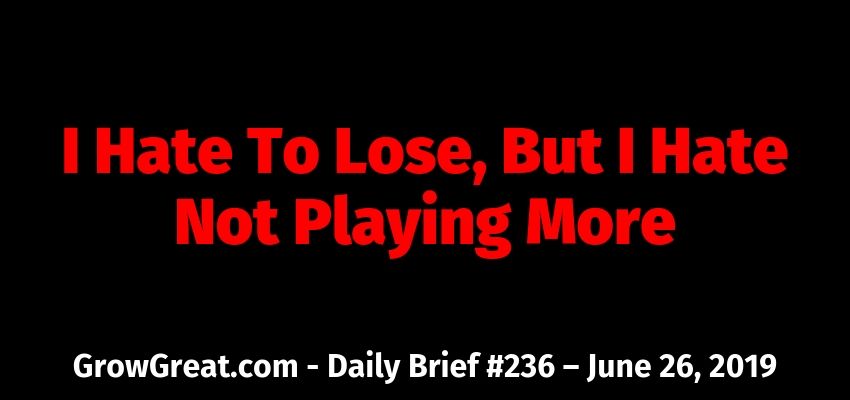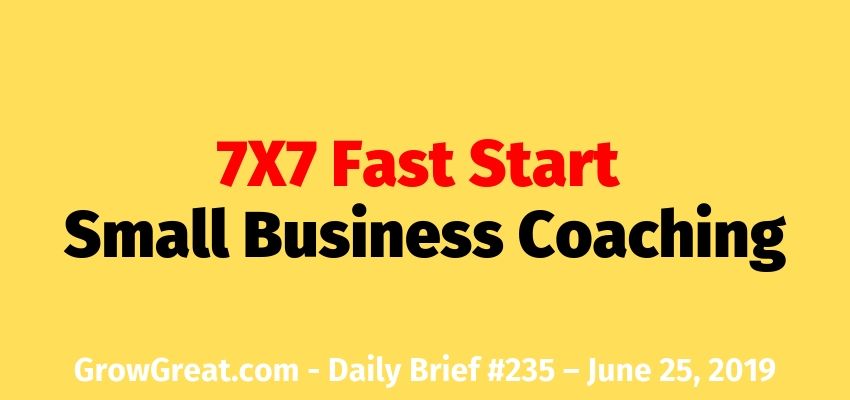Happy Birthday, Second Half Of 2019 – Grow Great Daily Brief #239 – July 1, 2019
Podcast: Play in new window | Download (Duration: 7:48 — 9.3MB)
Subscribe: Apple Podcasts | Spotify | RSS | More
Today I want to provoke you to take a quantum leap forward. It may be uncomfortable. Maybe it’ll be exciting. Let’s just give it our best to make it profitable.
Learning. Understanding. Growing.
Let’s start with a word. An important word. One that should remain at the forefront for you the rest of this year (and beyond).
Curiosity.
Get in touch with your curiosity. Don’t sweat about the object of it. Follow it. Spend some time with it so it becomes an improved habit – the habit of embracing it.
As a leader, you’re going to very quickly find yourself curious about any number of things pertaining to your career, your leadership, and your life.
I’ll throw some fuel on the fire. Think about the trifecta of successful business building:
- Getting new customers
- Serving existing customers better
- Not going crazy in the process
Follow your curiosity down these paths. Give it time. Ponder. Ruminate. Question. Question everything. Deeply.
Let one thing – just one thing – bubble to the top of everything else. You may not think there’s time to pursue everything. Just assume there is. Enough time. Concentrate on the one thing that you know – your gut won’t likely lie to you – will move the needle the most. And perhaps the fastest. It’s likely something that has been nagging you for quite some time. Something you’ve long been fretting about and feeling, “I really should do something about THIS.” For some reason, it has scared you off. So you put it off.
Stop wasting time. Now is the time to get on with it. Own the power to deal with IT today, on your terms. Time to engage this enemy.
Write it down. Your enemy. The object of your curiosity. The big question. It’ll be a question. If it’s not, make it a question.
It may be a “what if?” question.
It may be a “why can’t we?” question.
It may be a “who?” question.
Don’t rush into battle with this foe until you know what you’re up against. Figure out the question because this is the first real enemy you must conquer – clarity. Clarity on the true issue. It’s important that you get this right else you’ll spend time trying to figure out the wrong thing.
Sit still. Figure it out.
Ask yourself if this is really what you want to fix, solve, remedy or improve. Don’t advance until you’re sure. As sure as you can be. You can do this alone or solicit outside help. There’s enormous power in having others help, but don’t let that stop you from moving forward.
Once you’ve fully questioned the issue AND you’re satisfied that you’ve accurately identified the challenge, it’s time to write it down. Rewrite it as many times as you must to get the wording as clear as possible (you’re seeing a theme emerge – clarity). This question should be concise, clear and bluntly to the point. Don’t get caught up in fancy terminology or corporate lingo.
The focal point of the question is highly likely going to begin with one word: HOW.
How?
For example, many years ago my curiosity led me down a path of “I wonder if we can…?” After wrestling with it for a few days I morphed it into a how question. “How can we…?”
The result was a big, quantum leap innovation to accomplish never done before by our company or anybody in our market. In fact, at the time I didn’t know of anybody anywhere who did it. But my team did it. Rather quickly too. All because we identified the challenge, accepting it and refused to lose to it.
This process is my birthday gift to you for the second half. I hope you’ll try it because there’s no power in thinking about it. The power is in using it. Deploying it. And making it a habit for how you operate your life, your leadership and your business.
After tomorrow I’ll be dormant for the rest of this week. No, I’m not taking a vacation, or even a day off. But I’m going to be doing exactly what I’m challenging you to do in today’s show. I’m doing some work on what I want this podcast to look like and sound like for the rest of this year and moving forward.
Some questions I’m asking myself are:
a. If this podcast were like a party that I was hosting, who would I most want to attend?
b. If this podcast were like a party that I was hosting, what would I most want the theme to be?
c. Who do I most want to work with – translation, who do I most want to attract?
d. How can I provide the most value to that group of people?
e. What content would provide me the most joy and the audience the most value?
f. Where is the gap in the market for these things? Translation: where is my best opportunity?
g. What do I most want this podcast to be known for?
Just like you, the easy part is figuring out what I don’t want. Or who I don’t want to attract. Or the people I don’t want to work with. Or the things I don’t want to talk about. Or the subject matter I would quickly tire of.
I’d happily document the process, but it would likely bore you. Besides, I want you to focus on YOURSELF. Figure out what you need to figure out so the second half can be spectacular.
Lord willing, I’ll see you tomorrow, then we’ll return next week. Now get busy doing this work. Spend the rest of the week deeply devoted to getting something powerful done.
Be well. Do good. Grow great!
Randy
Happy Birthday, Second Half Of 2019 – Grow Great Daily Brief #239 – July 1, 2019 Read More »







